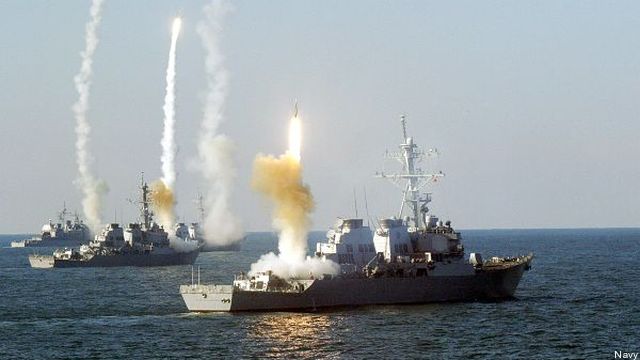By SYDNEY J. FREEDBERG JR
WASHINGTON: China or Russia could all too easily detect and destroy US Army missile defenses, exposing American forces to devastating attack, a forthcoming study finds. Patriot and THAAD units are big groups of big objects — launchers, radars, command posts — that emit lots of heat and radio/radar waves, are hard to camouflage, and can’t relocate quickly. To ensure our missile defenses can survive against near-peer threats, argues study lead author Tom Karako, the Army needs to decentralize its missile defense batteries, disperse the radars and launchers, and hide them in the terrain — a concept he calls “distributed defense.”
Making this concept a reality will require the Army to make new investments, Karako said. In particular, the service needs to finish its IBCS network to can connect these scattered components: A Patriot missile might fire at a target spotted by a faraway THAAD radar, for example. The Army needs to invest in better defenses against cruise missiles, drones (UAVs), and other threats that don’t fly the predictable ballistic arcs that Scuds and ICBMs do. And it needs to replace its current single-purpose launchers with ones that can load different types of missiles side by side, not only defensive but also defensive: The idea is similar to the Multi-Mission Launcher (MML) now in development for short-range missiles, but on a larger scale.
Scale is the big difference between the near-peer challenge and the threat against which most US missile defenses have been built, a rogue state firing crude Scuds or a small number of ICBMs. It’s great that the Pentagon’s independent tester has officially declared the nation’s Ground-Based Interceptors (GBI) can now “defend the U.S. homeland from a small number (of ICBMs) with simple countermeasures.” ButRussia and China each have thousands of ballistic and cruise missiles, many highly sophisticated, and they’re working on hypersonic ones.
THAAD missile launch
“This isn’t about how to do the North Korean ICBM thing differently. (It’s) Russia and China,” Karako told me in an interview on the study, which comes out today. “If we’re going to take seriously the National Defense Strategy (released last week), which is that great power conflict is our no. 1 priority… this is how one might think about transforming what we’ve been doing on air and missile defense to this new reality.”
The danger is not just the number of Chinese and Russian missiles but their variety, Karako said. “It’s the mixed threat problem, (aka) complex integrated attack — not just ballistic missiles or cruise missiles or UAVs but all at once,” he said, “using cruise missiles to target your ballistic missile defenses and vice versa.” Ballistic missiles fly a fast but predictable ballistic arc above the atmosphere. Cruise missiles and drones fly slower, in the atmosphere, but that means they can fly under radar and approach from unpredictable directions, like an aircraft. For the near future, both China and Russia are working on hypersonic boost-glide weapons, which are both fast andunpredictable. US Army missile defenses optimized against Scuds and crude North Korean ICBMs can’t necessarily handle these other threats — especially not all at once.

Chinese weapons ranges (CSBA graphic)
Learning From The Navy
The paradox of distributed defense is the Army can learn a lot about it from the Navy — but once the Army gets serious, it could decentralize, disperse, and hide its forces on land much better than the Navy can on the open sea.
“The Army has a ways to go,” Karako said. “They’ve been really busy on the counterterrorism fight.” But even now the Army is refocusing on high-tech warfare, he said, “you ain’t seeing a whole lot of imaginative and innovative thinking when it comes to transforming the air and missile defense force. For the most part it’s been more of the same: more Patriots, a little bit of IBCS to connect things.”
Patriot anti-missile battery.
By contrast, the Navy already implements many crucial components of distributed defense. Between the Aegis combat system on individual vessels, the Cooperative Engagement Capability(CEC) network, and the newer Naval Integrated Fire Control – Counter-Air(NIFC-CA) network, naval forces have a lot of capability to share precise targeting data on incoming threats. Navy experiments in recent years have proven that a Navy cruiser, destroyer, or even Littoral Combat Ship can hit enemy ships or missiles still hidden beyond the horizon, where its on-board radar cannot see, by downloading targeting data from other ships and aircraft that can see it. Networking this way also guards against malfunctions and battle damage: If your sensors go down, you can still connect to someone else’s.
The Army, though, can’t do this — yet. Today a Patriot launcher needs to get data from a Patriot radar and orders from a Patriot command center, a THAAD launcher must get data from an AN/TPY-2 radar, and so on. If the enemy can hack, jam, or blow up one radar, every launcher that depends on it goes blind.
The Army’s solution is the Integrated Air & Missile Defense Battle Command System (IBCS). In tests, IBCS hit both cruise and ballistic missile targets with Patriot interceptors, using targeting data not only from Patriot radars but from the Sentinel early-warning radar, which wasn’t even designed as a targeting system. It’s also exchanged data with the Navy CEC. But the IBCS software is staggeringly complex and has suffered significant delays.
IBCS is absolutely necessary for Army missile defense, Karako says, but it’s hardly sufficient. “IBCS, that’s really just the network and the command system,” he told me. “The goodness of that needs to be applied much more extensively.”

Aegis ships firing missiles
Versatile Launchers
One promising system — Karako calls it the Army’s “poster boy” and put it on the cover of his report — is the new Multi-Mission Launcher (MML). It’s the first component of the Indirect Fire Protection Capability (IFPC) to shoot down drones, rockets, and artillery shells, which will eventually include other weapons such as lasers as well.
The USS John Paul Jones test-fires an SM-6 missile from a Vertical Launch System (VLS)
Unlike Patriot, THAAD, and other legacy systems, the MML isn’t being built with its own fire control system and command posts: Instead, it’s being designed from the first to plug into IBCS. Also unlike Patriot, THAAD, et al, the MML isn’t custom-built to accommodate a specific kind of missile. Instead, it’s a general purpose “box ‘o rockets” that has successfully test-fired Stingers, AIM-9X Sidewinders, Longbow Hellfires, Miniature Hit-To-Kill (MHTK) missiles, and Tamirs from the Israel Iron Dome system. In fact, the MML can load different missiles side-by-side at the same time and fire whichever one has the best shot at the current target. (Some Patriot launchers can accommodate different variants of Patriot at the same time, but that’s nothing like MML’s versatility.)
That’s great, Karako said, but MML is only for relatively short-range threats. Why not adopt multi-purpose launchers across the air and missile defense arsenal, with a single launcher carrying (for example) Patriots and THAAD missiles side by side? Why not go even farther and have both offensive and defensive weapons in the same launcher, so it can either shoot down incoming missiles or — better yet — blow up enemy launchers before they fire?
Again, the Navy already has this capability: It’s called VLS. The Mark 41 Vertical Launch System standard on Navy cruisers, destroyers, and the future frigate can accommodate a wide variety of offensive and defensive weapons — from long-range Tomahawks to high-speed Standard Missiles — side-by-side at the same time. Before a ship deploys, Navy planners tailor its mix of missiles to the mission, and in combat, the commander and the Aegis software fire the appropriate missile at each target. There are even proposals to reload VLS cells at sea, enabling ships to rearm in mid-mission.

Aegis Ashore command center
Beyond Aegis Ashore
A land-based version of VLS already exists: It’s called Aegis Ashore. One site is already operational in Romania and Japan is building two sites. But “site” is a problem: Aegis Ashore is a static system, with radar, command center, and VLS tubes all built into a large complex. An enemy could target these fixed sites with Google Maps and an undergraduate’s understanding of ballistic rocketry. The Iranians and North Koreans probably couldn’t launch enough long-range missiles to make that matter, but China and Russia definitely could.
Instead of a fixed location, Karako says, it’s possible to fit at least two VLS tubes and a fire control system into a standard shipping container. The same space could also fit a pair of Patriots, some THAADs, or a wide variety of other missiles. Such a “containerized” launcher could go on the back of a truck, which could move it from place to place as needed — or drop it off amidst some trees where it could be hidden with camouflage netting. Or the container full of missiles could be left in a supply dump alongside hundreds of regular containers full of supplies, all externally identical — a needle in a stack of needles.

What if one were a hidden missile launcher? Could you find it?
The ability to hide, in fact, is the great advantage ground systems have over naval ones. A land-based missile launcher can be stripped down to a container, hidden somewhere and fired by remote control. A sea-based launcher has to float, and unless it’s permanently anchored it has to move, which means it has to have an engine, fuel, and (until AI improves) crew quarters — all of which makes it a bigger target. Worse, it’s a bigger target with less cover: Though islands block radar and shoals sonar, ultimately the sea is a flat surface. By contrast, the land domain is cluttered with both stationary objects — rocks, trees, buildings, mountains — and moving ones — birds, animals, civilians, vehicles — that make finding a specific target harder.
In short, while Army missile defenses today are less likely than the Navy’s to survive an all-out Chinese or Russian strike, in the future, with some modest investments and major rethinking, they could be more survivable. Right now, though, said Karako, the Army isn’t heading in that direction, despite some promising new concepts like Multi-Domain Battle, which acknowledges the long-range missile threat.
“if you believe in Multi-Domain Battle, if you believe what they say about the near-peer threat, and you believe that there’s lots and lots of air and missile threats out there that those folks are going to bring to bear,” Karako told me, “we’re going to have to do a lot more than just more of the same in terms of our air and missile defense.”
No comments:
Post a Comment